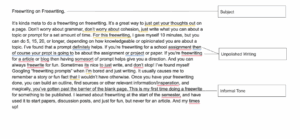Freewriting, by Kaylee Holtsclaw
How does a blank page make you feel? Beginning a piece of writing can send you into a flurry of emotions, but they don’t always have to be negative ones. Freewriting is a fun and no-stakes way to start writing your piece. It can turn what was boring or stagnant writing time into a creative brainstorming session where you discover ideas you didn’t even know you had.
So what is freewriting? It is a prewriting technique, where you allot yourself a certain amount of time to just write. You shouldn’t stop to fix spelling, grammar, conciseness, or anything of the sort; you simply write for as long and as much as you can. Don’t stop for anything. If you suddenly forget the difference between ‘there’, ‘their’, and ‘they’re’, that is alright; just keep writing. The point of freewriting is simply to get all of your thoughts out on paper, not to have a polished and finished product. Remember that it is only visible to you, so as long as you can understand it, there is no need for it to be overly formal or sophisticated.
The allotted time for the freewriting should be chosen on a case-by-case basis. If it’s a topic that you know a lot about, then you may give yourself a longer amount of time to write, and if it’s a topic you are new to, then you may keep the freewriting more brief. Personally, I have found ten minutes to be a sweet spot, but see what works for you.
Typically, you would have a prompt or a subject to focus your freewriting on. This prompt or subject will change depending on your reason for free writing. For example, if you’re tasked with writing a research paper on frog life cycles, then you would start your freewriting informally explaining what you already know. You could follow that with what you know about frogs in general or a personal frog-related story you have.
Here is an example of the freewriting I did for this very article. My subject or prompt was freewriting on freewriting. You can also see the informal tone of the whole thing. Freewriting is meant for your eyes, not others, so there’s no need for formalities. You will also notice the several red lines; these are spelling and grammar mistakes. When you’re freewriting, don’t let those little red lines scare you; it’s how you know you’re doing it right.
 If the red lines bother you, they can be turned off on most platforms. If you’re using a Google Doc, go to ‘tools’ in the top left, then ‘spelling and grammar’, and finally disable spelling and grammar suggestions. A word document is very similar, being ‘tools’, then ‘spelling and grammar’, then hide spelling and grammar errors. Don’t forget to turn off any extensions, such as Grammarly or Quillbot, because they will underline incorrect syntax too.
If the red lines bother you, they can be turned off on most platforms. If you’re using a Google Doc, go to ‘tools’ in the top left, then ‘spelling and grammar’, and finally disable spelling and grammar suggestions. A word document is very similar, being ‘tools’, then ‘spelling and grammar’, then hide spelling and grammar errors. Don’t forget to turn off any extensions, such as Grammarly or Quillbot, because they will underline incorrect syntax too.
You may come across the problem of being stumped on what to add to your freewrite. Don’t stop writing, even if that means writing the same word over and over. Once you stop, it’s hard to start again, so keep writing anything until you can get back on track.
The beauty of freewriting is that it lets you know what you don’t know. Use your completed freewriting, to identify holes in your knowledge. Those holes are where you should start your research.
Don’t let that blank page scare you. It’s truly nothing more than the canvas for your masterpiece. With freewriting, there are no critics, so just create and see where it takes you.

